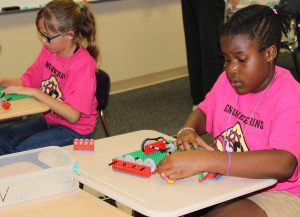As a father of young elementary and middle school-aged kids, I’m also curious to know exactly how my undergrad students came to be interested in mechanical engineering. An exchange with a UCF student might go like this: “You did a great job on the exam. Congrats! By the way, how did you get interested in mechanical engineering, anyway?” I mentally log the answers for my kids’ future benefit.
Any faculty member who is worth her or his salt will agree that teaching a class facilitates the instructor’s learning just as much if not more than the students in the audience. When we give challenging problems to our engineering students, they never cease to periodically impress us by deriving solutions that are more elegant than our own.
Every lecture and every office-hour interaction with our students, for that matter, is also a chance for us faculty to incrementally advance our knowledge.
After teaching approximately 50 courses, the hundreds of idiosyncratic informal discussions that I reflect on with students are by themselves insignificant, but as a collection definitely worth noting. When kids spend a significant amount of their free time in the garage working on cars or home-improvement projects or working on model cars or most common of all playing with Lego sets, some of them develop a disposition for technology.
Photo courtesy of Bailee McKay/Space Coast Society of Women Engineers
To the parents of kids who routinely and independently engage in these sorts of activities, you could very well have a budding mechanical engineer on your hands. Stay the course.
Minorities and women are underrepresented groups in science, technology, engineering and mathematics (STEM) fields. According to U.S. News & World Report, African Americans and Latinos comprise 5 and 6.2 percent of the engineering workforce, respectively. Depending on the source data, women comprise between 8 and 14 percent of mechanical engineers in the workplace. This gender imbalance in mechanical engineering classrooms is plain to see.
For parents of young daughters, we’ll need to be proactive in maintaining their interests in engineering and building abutments to hold off social distractions.
As a personal note, I grew up building Lego sets just like many of my past and present students. Back then my interests were totally captured by the classic space-themed sets, and when I got a little older I could not be separated from the Technic sets featuring planes, cranes and automobiles designed for ages 11 to 16. Santa never delivered Lego Technic Space Shuttle (8480), but I still have hope.
Rather than just static structures, these more technically oriented sets feature gears, springs, pulleys, pneumatics, etc. They are abundant in their composition with the machine components essential to mechanical engineering design. Very frequently, I use gears, springs, and simple Lego constructions to help demonstrate concepts in classes and STEM summer camps.
In 2011, The Lego Group reported that 90 percent of its customers were boys; consequently, the following year Lego introduced the Lego Friends product line designed primarily for girls to relieve the gender imbalance. Think pink, purple, yellow and green hues with building sets featuring scenes in performing arts, animal rescue, camping, restaurants and the like.
They absolutely nailed it and won numerous industry and parents’ choice awards. I was delighted and my four daughters have snapped up and snapped together nearly 135 Lego Friends kits. Other toy makers, like GoldieBlox and K’Nex Mighty Makers, have also tapped into this segment. These have been successful in getting more pre-teen girls thinking about engineering.
With an eye vectored towards maintaining and even enhancing our daughters’ positive attitude concerning engineering, there needs to be more pre-engineering toys and games that continue to engage girls’ free-time interests, especially in the early teenage years. The products that would help to facilitate this, however, leave a lot to be desired.
The Lego Group, for example, has made no compelling effort to expand the Technic product line beyond the race cars and dump trucks that it has had for decades. Visit your neighborhood Target or Walmart to see that STEM-oriented toy and game products only show up in the “boy” aisles. The implicit message in this gender-segregation is that technology is not for our daughters.
No recent Lego Design videos featuring Lego-employed master builders, showing their creations on YouTube, contain women or members of minorities groups. The consequences of this and numerous other idiosyncratic events are individually insignificant but collectively forceful in their contribution toward gender-filtration. The imminent challenges of our society’s tomorrow compels us to begin formulating a diverse and capable workforce today.
Rather than merely highlighting the issue, here’s some suggestions for candidate Lego Technic, K’Nex, etc. sets that would appeal across the aisles to those in their early teen years:
Let me know if you need these products tested in class, at camp or at home.
Whether these things appear on the shelves is not something on which we parents should be fixated, however. If we want our daughters to have predilections toward technology, a “girl’s” or “gender-neutral” version of a product isn’t necessarily the best solution. The most elegant solution is helping her to identify problems in her world and then giving her the tools, materials, guidance and freedom to come up with her own solution.
Play well.
Ali P. Gordon is an associate professor in UCF’s Department of Mechanical & Aerospace Engineering. He can be reached at ali@ucf.edu.

